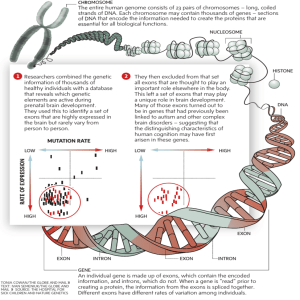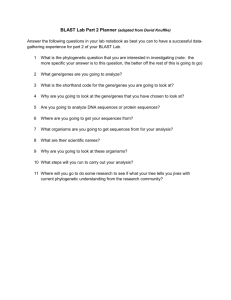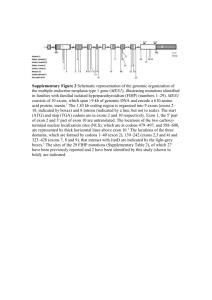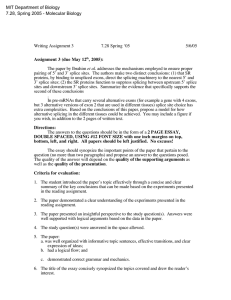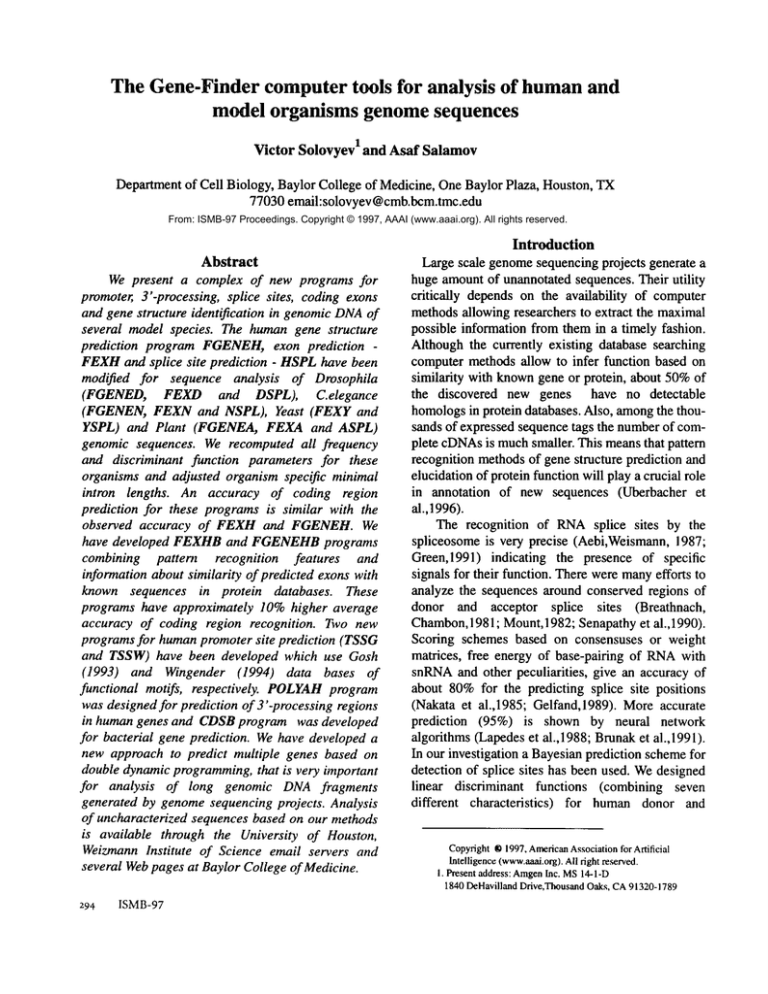
The Gene-Findercomputertools for analysis of humanand
model organisms genome sequences
Victor Solovyev land Asaf Salamov
Departmentof Cell Biology, Baylor College of Medicine, OneBaylor Plaza, Houston, TX
77030 email:solovyev @cmb.bcm.tmc.edu
From: ISMB-97 Proceedings. Copyright © 1997, AAAI (www.aaai.org). All rights reserved.
Abstract
We present a complex of new programs for
promoter, 3’-processing, splice sites, coding exons
and gene structure identification in genomicDNAof
several model species. The humangene structure
prediction program FGENEH,exon prediction FEXHand splice site prediction - HSPLhave been
modified for sequence analysis of Drosophila
(FGENED, FEXD and DSPL), C.elegance
(FGENEN, FEXN and NSPL), Yeast (FEXY
YSPL) and Plant (FGENEA, FEXA and ASPL)
genomic sequences. We recomputed all frequency
and discriminant function parameters for these
organisms and adjusted organism specific minimal
intron lengths. An accuracy of coding region
prediction for these programsis similar with the
observed accuracy of FEXH and FGENEH. We
have developed FEXHBand FGENEHBprograms
combining pattern recognition features and
information about similarity of predicted exons with
known sequences in protein databases. These
programs have approximately 10% higher average
accuracy of coding region recognition. Two new
programsfor humanpromoter site prediction (TSSG
and TSSW) have been developed which use Gosh
(1993) and Wingender (1994) data bases
functional motifs, respectively. POLYAH
program
was designed for prediction of 3"-processing regions
in human genes and CDSBprogram was developed
for bacterial gene prediction. We have developed a
new approach to predict multiple genes based on
double dynamic programming,that is very important
for analysis of long genomic DNA fragments
generated by genomesequencing projects. Analysis
of uncharacterized sequences based on our methods
is available through the University of Houston,
WeizmannInstitute of Science email servers and
several Webpages at Baylor College of Medicine.
294
ISMB-97
Introduction
Largescale genomesequencing projects generate a
huge amountof unannotated sequences. Their utility
critically depends on the availability of computer
methodsallowing researchers to extract the maximal
possible information from them in a timely fashion.
Although the currently existing database searching
computer methods allow to infer function based on
similarity with knowngene or protein, about 50%of
the discovered new genes have no detectable
homologsin protein databases. Also, amongthe thousands of expressed sequence tags the numberof complete cDNAs
is muchsmaller. This meansthat pattern
recognition methodsof gene structure prediction and
elucidation of protein function will play a crucial role
in annotation of new sequences (Uberbacher et
a1.,1996).
The recognition of RNAsplice sites by the
spliceosome is very precise (Aebi,Weismann,1987;
Green,1991) indicating the presence of specific
signals for their function. There weremanyefforts to
analyze the sequences around conserved regions of
donor and acceptor splice sites (Breathnach,
Chambon,
1981; Mount,1982; Senapathyet al.,1990).
Scoring schemes based on consensuses or weight
matrices, free energy of base-pairing of RNAwith
snRNAand other peculiarities, give an accuracy of
about 80%for the predicting splice site positions
(Nakata et a1.,1985; Gelfand,1989). Moreaccurate
prediction (95%) is shown by neural network
algorithms (Lapedeset al.,1988; Brunaket a1.,1991).
In our investigation a Bayesianprediction schemefor
detection of splice sites has been used. Wedesigned
linear discriminant functions (combining seven
different characteristics)
for humandonor and
Copyright ~ 1997, AmericanAssociation for Artificial
Intelligence (www.aaai.org).All right reserved.
I. Present address: AmgenInc. MS14-1-D
1840 DeHavillandDrive,ThousandOaks, CA9 i 320-1789
acceptor splice site identification and achieved 9697%accuracy (Solovyev, Lawrence, 1993; Solovyev
et al., 1994).
Most gene prediction
systems combine
information about functional signals and the
regularities of coding and intron regions. The
program SORFIND(Hutchinson, Hayden, 1992)
was designed to predict internal exons based on
codon usage and Berg &von Hippel (1987)
discrimination energy for intron-exon boundaries
recognition. An accuracy of exact internal exons
prediction (at both 5’ and 3’ splice junctions and in
the correct reading frame) by SORFIND
program
reaches 59%with a specificity of 20%. A dynamic
programmingapproach(alternative to the rule-based
approach) was applied by Snyder and Stormo (1993)
to internal exon prediction in GeneParseralgorithm.
GeneParser recognized 76%of internal exons, but
the structure of only 46% exons was exactly
predicted when tested on entire GenBankentry
sequences. Recently, the Genie system using a
Generalized Hidden Markov Model has been
developed.It is similar in design to GeneParser,but
is based on a rigorous probabilistic framework
(Kulp et a1.,1996). Wehave developed a program
(HEXON) based on a splice site prediction
algorithm and preferences of oligonucleotides in
protein coding and intron regions (Solovyevet al.,
1994). HEXON
had a better exact exon prediction
quality than the other internal exon prediction
programsand maybe useful for analysis of partially
sequenced genes.
A number of gene structure prediction programs
have been developed to assemble potential eukaryotic
coding regions into translatable mRNA
sequence
selecting optimal combinations of compatible exons
(Fields & Soderlund,1990; Gelfand,1990; Guigo et
al., 1992; Dong & Searls,
1994). Dynamic
programmingwas suggested as a fast methodto find
an optimal combination of preselected exons
(Gelfand, Roytberg, 1993; Solovyev, Lawrence,
1993b; Xu et a1.,1994), that is different from the
approach suggested by Snyder and Stormo (1993)
search for exon-intron boundary positions. Wehave
combined5’-, internal and 3’-exon identification
linear discriminant
functions and dynamic
programming approaches in our gene prediction
system (Solovyev et a1.,1994-95). A comprehensive
test of our and the other gene finding algorithms has
been made recently by the developers of GenelD
algorithm (Burset, Guigo,1996). Our GeneFinder
program (FGENEH)
(Solovyev et a1.,1995) is one
the best in the tested group having the exact exon
prediction accuracy 10%higher than for the others
and the best level of accuracy on the protein level.
The same best performance of FGENEH
was shown
by the developers of Genie (Kulp et al.,1996). The
above mentioned tests were done without using any
information about possible similarity of analyzed
sequence and a knownsequence in the data base. If
the similarity exist, GeneID, GeneParser and
GeneFindervariants can exploit this information and
they showmuchbetter accuracyin this case.
Whilesignificant success has been madein coding
region identification, however,perfect prediction of
eukaryotic gene structure continues to be a
challenging problemto the biologist trying to deduce
the translated proteins from the genomicsequences.
Also, we need to develop specific programs for
analysis of genomic DNAfrom different species as
long as it has becomeclear that the rules of splicing
might be dissimilar in different taxonomicclasses
(Mount, 1993). There are several genomesequencing
projects have been launchedfor different organisms,
therefore it is extremely important to develop
software for analysis of their sequences. This workis
mostly devoted to extension of our humanGeneFinder tools to identification of splice sites, exons
and gene-structure in several model organisms as
well as prediction of multiple genes in long genomic
DNA.
Results and Discussion.
Predicting splice sites in modelorganisms
Wehaveused the samecharacteristics for splice site
identification whichwere selected during our analysis of human genes (Solovyev, Lawrence, 1993;
Solovyevet a1.,1994). The characteristics computed
for classifying donor site are: the triplet preferences
in the potential coding region (-30 to -5), conserved
consensus region (-4 to +6) and G-rich region (+7
+50); the numberof significant triplets in the conserved consensus region; octanucleotide preferences
of being coding in the -60 to -1 region and intron in
the +1 to +54 region; and the number of G-bases,
GG-doublets and GGG-lriplets in the +6 to +50
region. The characteristics for acceptor splice sites
are: the triplet preferencesin the branchpoint region
(-48 to -34), poly(T/C)-tract region (-33 to -7),
served consensusregion (-6 to +5), coding region (+6
Solovyev
295
to + 30); octanucleotide preferences of being coding
in the (+1 to +54) region and intron in the (-1 to -54)
region; and the numberof T and C in poly(T/C)-tract
region. Welearned statistical parametersof our splice
site discriminant functions from Drosophila, Nematode, Yeast and Plant (Arabidopsis)
genomic
sequences. The accuracy of splice site recognition by
DSPL, NSPL, YSPL and ASPL programs is estimatedon the genes that have not been included in the
learning set (Table 1). A group of gene sequences
presented to the GenBankin 1996 were taken as a
test set (here and in the following sections), while
genes deposited before that year were used as a learning set.
Table1. Theaccuracyof splice sites identification.
Organism
splice site
#examples
(Sn + Sp)/2
Corr. coeff.
Drosophila
donor
874/287
95.5%
0.61
Drosophila
acceptor
883/287
95.5%
0.62
Nematode
donor
6761/856
95.0%
0.59
Nematode
acceptor
6770/841
95.0%
0.60
Yeast
donor
845114
96.0%
0.67
Yeast
acceptor
856/14
9O%
0.46
Plant
donor
497/1009
95.5%
0.65
Plant
acceptor
499/988
93.0%
0.56
Shown
the number
of examples
in the learning/test sets; Sn
(sensitivity), Sp(specificity)andcorrelationcoefficient
usual measuresof accuracy; (Sn+Sp)/2wassuggested as
an integral measurein (Fickett,Tung,1993)
Weobserve enough good accuracy of splice site
prediction for analyzedmodelorganisms.It is similar
with our results received for humangenes. However,
wecan see small decrease of quality that mayhint to
search for newfeatures specific for these organisms.
A newplant splice site prediction methodcombining
neural network and rule based approaches was
designed recently (Hebsgaard et a1.,1996). It combines local and global information and its accuracy
should be comparedwith results of gene-structure
prediction programs.
Predicting 5’-, internal, 3’- codingexons.
For exon prediction we also took the same characteristics of discriminant functions that were selected
for humangenes. During internal exon recognition
weuse the octanucleotide preferences of being intron
in the potential left intron region; the value of the
acceptor splice site recognition function, the ORF
296
ISMB-97
octanucleotide preferences of being coding, the value
of the donor splice site recognition function and the
octanucleotide preferences of being intron of the
right potential intron region.
As 5’-exon candidates weconsider all open reading
frames that starting with an ATGcodon and ending
with a GT dinucleotide. As components of the 5’exon recognition function wetake the hexanucleotide
preferencesfor 5’-regions - 150 - - 101 bp, - 100- -51
bp, -50 - -1 bp of being to the left of the potential
codingregion; the average value of positional triplet
preferences in the -15 - +10 region around ATG
codon; octanucleotide preferences to be coding
region of ORF,the value of donor splice site recognition function and the octanucleotide preferences of
being intron of the right potential intron region.
As potential 3’-exons we consider all ORFregions
starting after AGbase pair and finishing with a stop
codon. As components of the 3’-exon recognition
function we take the octanucleotide preferences of
being intron of the left potential intron region; the
value of the donor splice site recognition function;
octanucleotide preferences in ORFto be coding
region, hexanucleotide composition preferences for
3’-region +1- +50 bp, +51 - +100bp, +101- +151bp
to the right of the potential codingregion; the average
value of positional triplet preferencesin the - 10 - +30
region around the stop codon.
Welearned statistical parameters of our exon discriminant functions from knowngene sequences of
different species. The accuracy of exon recognition
Organism
exolls
by programs FEXD, FEXNand FEXAfor the test
set sequencesis presented in Table2.
Table 2. The accuracyof exon identification.
#examples
(Sn + Sp)/2
Corr. coeff.
Drosophila
internal
166/78
94.5%
0.90
Drosophila
all
478/152
87.0%
0.80
Nematode
internal
4528/423
95.0%
0.91
Nematode
all
6562/605
92.0%
0.88
Plant
internal
287/443
94.2%
0.89
Plant
all
457/665
93.5%
0.79
Weobserve a good accuracy of internal exon prediction (94-95%). But flanking exons are predicted
much less accurate. This is a commonfeature of
many exon prediction programs. For example, the
GeneParser internal exon prediction tested on
sequences between the first and the last exons had
correlation coefficient (C) about 0.8. However,prediction on the whole gene sequences resulted with
C---0.68 (Snyder, Stormo,1993).Wesuppose that this
effect is dueto poor identification powerof 5’- and3’end characteristics in exon discdminant functions.
Their improvementis one of the main task of future
workin gene recognition.
Prediction of gene structure.
Weapplied dynamicprogrammingto predict optimal
gene model from the list of potential exons. The
methodhave been described for humansequences in
(Solovyev et. a1.,1995). The same procedure was
implementedin programs of gene structure prediction for model species. Only minimalintron length
was changedto 30 bases and organism-specific splice
site and exon prediction functions described above
were used. Theresults of applying gene identification
programs FGENED, FGENEN and FGENEA to
the test set of sequencesare presentedin Table3.
Table 3. The accuracyof gene structure prediction.
Organism
# test examples
(Sn + Sp)f2
Corr. coeff.
Drosophila
152
90.5%
0.86
Nematode
605
92.0%
0.88
Plant
665
90.5%
0.86
These programs have usually a better accuracy than
the total accuracyfor separate exons (5’, internal and
3’) prediction. However,they can produce a wrong
result if a sequence contained manygenes. In this
case it wouldbe better to search for exons without
their assembling or apply new technique considered
below.
Using database homology search
Wehave developed the versions of FGENEH
and
FEXH(referred
as FGENEHBand FEXHB) which
combine pattern-recognition exon prediction and
information about similarity between translated
amino acid sequences of the predicted exons and
Solovyev
297
knownsequences in a protein database. Addition of
homology information often may significantly
increase an accuracy of gene-finding programs, especially whena close homologsoccur in the database
(Burset, Guigo, 1996). Recently some variants
gene prediction programs exploiting a similarity
search have been developed, such as GenelD+
(Guigo et al, 1992), GeneParser+(Snyder, Stormo,
1995) and GRAIL(Xu,Uberbacher, 1996).
In FGENEHBand FEXHB we use a lower
thresholds for the corresponding discriminant functions than in FGENEH
and FEXH,to allow analyze
a greater numberof potential exon candidates. Database searches with the translated amino acid
sequences of predicted exons is performed by the
FASTAprogram (Pearson,
Lipman, 1988).
decrease the search time, we create one amino acid
sequence for each cluster of overlapping exons with
the same translation frame. In the current implementation of FGENEHBand FEXHBwe only modified the original weights of predicted exons by adding
an additional term which is proportional to the
observed homology level. From the FASTAoutput
beginningwith the first hit weextract homology
level
between our query sequence (in this case the translated aminoacid sequenceof the potential exon) and
the high-scoring database sequences selected by
FASTA.If some fragments of query sequence is not
covered by the first hit, the homology level is
extracted from the subsequent4 best hits. After that
we compute the average homology level for each
potential exon. The original weightsof these exons is
augmentedby the additional term, non-linearly proportional to the average homologylevel (higher scaling factors for the higher homologylevel). Table
presents the results of FGENEHB’s
performance on
a dataset of 570 entries compiled by Burset and
Guigo (1996) in comparison with the results
GenelD+ and GeneParser 3 which also used
homologyinformation from the protein database.
Table 4. Performanceof gene-recognition programs,
using homologyinformation from the protein databases for the dataset of 570 GenBank
entries (Burset
& Guigo, 1996)
Nucleotlde
Sn
Sp
Ac
Cc
Sn
Sp
ME
WE
+
Fgenehb
++
GenelD+
0.92
0.96
0.92
0.92
0.74
0.78
0.09
0.02
0.91
0.91
0.88
0.88
0.73
0.70
0.07
0.13
++
GeneParser3
0.86
0.91
0.86
0.85
0.56
0.58
0.14
0.09
+) In the testing the first FASTA
hit wasnot considered,to
removepossibleexact protein productof the gene. ++)The
values for GenelD+
and GeneParser3are taken fromthe
article of BursetandGuigo(1996).
This simplewayof accountingsimilarity information
could be used with ESTdatabasealso.
Prediction of multiple genes.
Currently there is no programthat can predict several genes without using any information about the
structure of knownsimilar sequences. The behavior
of knowngene-finding algorithms is unpredictable in
this case. Theycould either predict genes containing
exons from the other genes or they could identify the
only one right gene havingthe highest score.
Weapplyed double dynamic programmingto develope a new gene structure prediction algorithm by
analyzing many possible gene models in a given
z98
Exact exon
ISMB-97
sequence and selecting someoptimal combination of
them. Let consider a short description of this
approach. Eachpredicted exon is characterized by its
weight (the LDFvalue) and reading frame {0,1,2}.
Anarray of such exons ordered according their start
positions could be presented as vertices in the
directed acyclic graph. Wewill call any 2 exons as
compatible (i.e. connected by an edge in the graph)
if: 1) the first exonis either 5’ or internal exonandthe
secondexon is either internal or 3’-exon; 2) the distance betweenthe first exon end and the second exon
start is morethan the minimum
intron length (60bp in
humangenes); 3) the ORFsof these exons are compatible upon their merging, i.e after removingthe
corresponding intron sequence the combined ORF
will contain no in-frame stop codons. Our algorithm
consists of 2 successive dynamicprogrammingsteps.
Duringthe first step for each exonpair (the first exon
is either 5’ or internal and the secondone is internal
or 3’) we look for an optimal gene model beginning
with the first exon and ending with the second (optimal model is one with the maximal total weight).
This problem corresponds to the well-known problem of finding shortest (or longest) path betweenall
pairs of vertices in the directed acyclic graph (Cormenet al.,1990) and can be solved by dynamicprogramming.If N is the numberof preselected exons,
then the maximal number of all considered gene
modelsis (N-1)*(N-2)/2(if all exons are internal
non overlapping with each other). In practice the
actual number of gene models is much lower,
because: 1) we analyze only the modelswith an average exon weight higher than a certain threshold; 2)
we exclude all models which are subsets of larger
models; and 3) only compatible exons could be connected in the graph. During the second step we consider an array of potential gene modelswhichordered
according their start positions as vertices of new
directed acyclic graph. Eachsuch modelis characterized by the total weights of exons belongingto it. We
define any 2 gene modelsas compatibleif: 1) the distance between them is greater than a minimal distance between 2 consecutive genes observed in
humansequences; 2) they are not covered by a larger
model with an average exon weight higher than the
average weights for the small models. Wealso use
dynamic programming to find the model combination (or the path in the directed acyclic graph) with
maximaltotal weight. Thevertices of this path correspond to the potential gene models.
Weimplemented this double dynamic programming
approach in FGENEM
program and tested it on several long sequences containing gene clusters. As the
first example the well known HUMBB
GenBank
sequence of 73308 bases including five ~-globin
genes and one pseudogene was selected.
The
FGENEMprogram predicted
5 genes in this
sequence, g-gamma, a-gammaand beta-globin genes
were predicted exactly; epsilon-globin gene was
identified almost right, only its 5’-exonwas 18 amino
acid shorter at the beginning;in delta-globin genethe
last exon was predicted exactly, the second exon partially and the first exon wasmissed. So, wecorrectly
defined the numberof potential genes, and exactly
predicted positions of 12 exons, 2 exons were predicted partially and only 1 wasnot found in this long
sequence.
The next test example was taken from the recent
work of Xu and Uberbacher(1996) where the authors
presented their approach to predict multiple genes
base on information about knownhomologous protein sequencesin the database. Theycreated artificial
sequence by combining three one-gene GenBank
entries (HUMCYPBE
of 9 exons; HUMRASH
of
exons and HUMACTGA
of 5 exons). Our program
found exactly 3 genes in this sequence. The structure
of HUMRASH
gene was predicted perfectly. 4 of 5
exons of HUMACTGA
were found correctly and one
was defined by 2 amino acid shorter than real. Six
exons of HUMCYPBE
were predicted exactly, 2
were overlapped and one was missed. Our results is
not significantly different from the prediction
approach that used information about similar
sequences in protein database. That approach illustrated only on this examplealso missed one exon and
predicted one extra (Xu & Uberbacher,1996).
understandthat thereis a lot of workcould be done to
provide goodempirical parameters for this algorithm,
however considered above preliminary results
encourageits future development.
Recognition of promoter regions in humanDNA.
Eukaryotic polymeraseII promoter sequences are
the main functional elements of eukaryotic genes.
Their recognition by computer algorithms will
increase the quality of genestructure identification as
well as provide possibility to study gene regulation.
However, development of computer algorithms to
recognize Pol II promoter sequences in genomic
DNAis an extremely difficult problem of computational molecular biology. Promoter5"-flanking region
is very poorly described in general. It maycontain
dozenshort motifs (5-10 bases) that serve as recognition sites for proteins providing initiation of transcription as well as specific regulation of gene
expression. These motifs are different in various
groups of genes and even such knownpromoter element as TATA-box
is often absent in 5’-regions of
many house-keeping genes. Each promoter has a
unique selection and arrangement of these elements
providing a unique programof gene expression. Currently, the only one knownprogram (PromoterScan)
can predict promoterregions with a relatively small
false positive rate (Prestridge,1995). The program
searches for eukaryotic promoter regions using a
motif data set and can recognize about 50%of test
promoter sequences.
Recently we have developed 2 new programs
Solovyev
299
(TSSWand TSSG)for eukaryotic promoter identification. Theyanalyze occurrence of functional motifs
from 2 databases (Ghosh,1993) and ( Wmgender,1994), respectively and sequence composition
characteristics of potential promoterregions and transcription start sites (TSS). The maincompositional
characteristics are positional triplet preferences
around the potential start of transcription; hexaplet
preferences in the regions -1 - -101, -101- -201 and 201 - -301 relative to TSS; the score of TATAbox
weight matrix. The programscan predict positions of
transcription initiation and binding sites of transcription factors for approximately 50%of knownpromoters with one false positive prediction for about
5000 bases of genomic DNA.They provide a better
average accuracy of locating TSSpositions than the
previously developed method(Prestridge,1995). For
example, when we analyzed 10 promoter recognizable by both methods (TSSG and PromoterScan) the
average deviation of predictions by TSSGprogram
from the real TSSwas about 10 bases, while for PromoterScan predictions this characteristic was 70
bases.
and algorithmfor identification of 3’-processingsites
of humanmRNA
precursors. The algorithm is based
on a linear discriminant function (LDF)trained
discriminate real poly-A signal regions from the
other regions of human genes possessing the
AATAAA
sequence which is most likely nonfunctional. As the parameters of LDFvarious significant
contextual characteristics of sequences surrounding
AATAAA
signals were used. Weused for analysis a
300 nucleotides sequence region (-100, +200) around
AATAAA
hexamer (the location of the first base of
AATAAA
is defined as position 1). Pseudosites were
taken out of humangenes as the sequences comprising (-100,+200)around the patterns revealed by polyA weight matrix (see below), but not assigned
poly-Asites in the Feature table. Sequencessubmitted to GenBankbefore 1994 were included to the
training set and those after 1994to the test set. Asa
result there were 248 positive and 5702 pseudosites
in the training set and respectively 131 and 1466in
the test set. As characteristics of poly-Adiscriminant
function we selected: 1) Position weight matrix for
scoring of poly-Asignal; 2) Position weight matrix
for scoring of downstream GT/T-rich element; 3)
Recognition of 3’-regions of humangenes.
Distance between poly-A signal and predicted downOneof the distinguishing fragments of eukaryotic
stream GT/T-rich element; 4) Hexanucleotide comtranscripts is the 3’-untranslated region (3’UTR)
position of downstream (+6,+ 100) region;
which has the diversity of cytoplasmic functions
5)Hexanucleotidecompositionof upstream(- 100,affecting the localization, stability and translation of
region; 6) Positional triplet composition of downmRNAs
(Decker and Parker, 1995). Recently there
stream (+6,+55)region; 7) Positional triplet composihave been a few attempts to predict 3’-processing
tion of upstream(-50,-1) region, 8)Positional triplet
sites by computational methods. Yada et al (1994)
composition of the GT/T-rich downstreamelement.
have conducted a statistical analysis of humanDNA
Detailed description of these features and the method
sequencesin the vicinity of poly-Asignal in order to
was presented in (Salamovand Solovyev, 1997).
distinguish them from nonactive in polyadenylation
The most significant characteristic is the score of
AATAAAsequences occurring
in human DNA
AATAAA
pattern (estimated by the position weight
(pseudopolyA-signals). Theyfound that a base C frematrix) that indicates the importanceof occurrences
quently appears on the upstream side of the
of almost perfect poly-A signal (AATAAA).
The secAATAAA
signal and a base T or C often appears on
ond valuable characteristic is the hexanucleotide
the downstreamside, implying that CAATAAA(T/C) preferences of downstream (+6,+100) region.
can be regarded as a consensus of the poly-Asignal.
Althoughthe discriminating ability of GT-richdownKondrakhin et al (1994) constructed a generalized
stream elementitself (characteristic 2) is very weak,
consensus matrix using 63 sequences of cleavage/
combiningit with the other characteristics signifipolyadenylation sites in vertebrate pre-mRNA.The
cantly increases the total Mahalonobisdistance.
elements of their matrix were absolute frequencies of
Whenthe threshold was set to predict 86%of poly-A
triplets at each site position. Usingthis matrix they
regions correctly, specificity of 51%and correlation
have provided a multiplicative measure for recognicoefficient of 0.62 had been achieved. The precision
tion of polyadenylation regions. However their
of this approachis better than for the other methods
methodhas a very high false positive rate.
(see, for example, a recent one by Kondrakhin et
We have developed a computer program POLYAH
a1.,1994) and has been tested on a larger data set.
300
ISMB-97
Kondrakhinet al (1994) did not report the total prediction accuracyof their method.Instead, they tested
their recognition function for the sequence of adenovirus (Ad2) genome. This sequence (35937 bp)
tains poly-A sites for nine transcripts which are
polyadenylated at different stages of Ad2onthogenesis. Authorsreported the error rates of their methodat
different thresholds for poly-Asignal selection. If the
thresholdis set to predict 8 of 9 real sites their function also predicts 968 additional false sites. Wehave
tested the POLYAH
program with the same sequence
of Ad2genomeand for 8 correctly predicted sites it
gives only 4 false sites. In general, the accuracy of
POLYAH
is significantly better than provided by
previous two methods. While about 86%of real polyA regions can be predicted correctly, the moreprecise
recognition will need an additional study of these
complexgene regions.
Prediction of bacterial genes.
A new method has been developed to find protein
coding genes in E.coli DNA.The methodis based on
the discriminant analysis of open reading frames
flanked ATG(GTG)
and STOPcodon pairs. Prediction is performed by linear discriminant function
combining characteristics describing 5’-, 3’-mRNA
regions and coding region for each open reading
frame: octanucleotide preferences for coding region;
in-frame octanucleotide preferences for coding
region; hexanucleotideprefernces of -30 - +10 region
around (ATG/GTG)
codons; hexanucleotide
prefernces of -10 - + 30 region around stop codons;
positional triplet preferences around (ATG/GTG)
codons and positional triplet preferences around
potential stop codons. The parameters of the linear
discriminant function was computed using 3000
E.coli sequences of annotated DNAin GenBank
(1994) entries. The performance of bacterial gene
prediction program CDSBwas estimated on 1000
genes presented to GenBankin 1995. The recognition quality computedat the level of individual nucleotides is 94%and 75%for precise recognition of
gene locations.
The methodsavailability.
Our computer programs for sequence analysis are
installed in several genomesequencing centers such
as U.C. Berkeley, ColumbiaUniversity, Washington
University, National Institute of Health, Wisconsin
Medical College, UKMRCHGMPResource Centre
and in 2 email servers (University of Houston and
WeizmannInstitute of Science). Wehave developed
several WWW
pages using HTML
and Perl scripts.
For example, "Lost protein trail" Webpage: (http:ll
defrag.bcm.tmc.edu:95031Ipt.html) unites 21 programs for splice site, promoter and gene structure
prediction for different species; 4 programsfor protein secondary structure and prosite pattern prediction and programs for fold recognition. This WWW
page usually provides new version of programs as
comparing with Email servers and others WWW
sites
(see,
for
example,
http’J/
dot.imgen, bcm.tmc.edu:9331/gene-finder/gf.html
and http:lldot.imgen.bctmtmc.edu:9331/pssprediction/pssp.html).
References.
AebiM., Weissmann
C. (1987) Precision and orderliness
in splicing.Trendsin Genetics,3, 102-107.
Breathnach R.,ChambonP. (1981) Organization and
expressionof eukaryoticsplit genesfor codingproteins.
Ann.Rev.Biochem.,
50,349-393.
Berg, O.G., yon Hippel, P.H. (1987). Selection of DNA
bindingsites by regulatoryproteins. J.Mol.Biol.,193, 723750.
BursetM., GuigoR. (1996), Evaluationof genestructure
prediction programs,Genomies,34(3), 353-367.
CormenT.H., Leiserson C.E., Rivest R.L. 1990.
Introductionto Algorithms.MITPress.
Decker C.J. and Parker R. (1995) Diversity
cytopasmaticfunctions for the T-untranslatedregion of
eukaryotictranscripts. CurrentOpinionsin Cell Biology
1995,7: 386-392.
DongS., Searls D.(1994),Genestructure prediction
linguistic methods,Genomics,
23, 540-551.
Brunak,S.; EngelbrehtJ.; Knudsen
S. (1991)Prediction
HumanmRNA
donor and acceptor sites from the DNA
sequence.J. MoLBiol.
220: 49-65.
EfronB., TibshiraniR. (1991)Statistical data analysis
the computerage. Science,253, 390-395.
Fickett J.W.; TungC.S. 1992. Assessmentof Protein
CodingMeasures.Nucl. AcidsRes. 20: 6441-6450.
Fields C.,SoderlundC. (1990) GM:a practical tool for
automating DNAsequence analysis", CABIOS,6, 263270.
GelfandM. (1989)Statistical analysis of mammalian
premRNA
splicing sites, NucleicAcids Research,17, 63696382.
Gelfand M. (1990), Global methods for the computer
prediction of protein-coding regions in nucleotide
sequences,Biotechnology
Software,7, 3-11.
GelfandM.,RoytbergM. (1993), Prediction of the exonintron structure by a dynamicprogrammingapproach,
Solovyev
301
BioSystems, 30(1-3), 173-182.
Ghosh, D. (1993). Status of the transcription factors
database (TFD). Nucl. Acids Res.21, 3117-3118.
Green M.R. (1991) Biochemical
mechanisms
constitutive
and regulated
pre-mRNA splicing.
Ann.Rev.CellBio!.,7,559-599.
Guigo R.; Knudsen S.; Drake N.;Smith T.(1992)
Prediction of gene structure.J.MoI.Biol.226:141-157.
Hutchinson G.B., Hayden M.R. 1992. The prediction of
exons through an analysis of splicible open reading
frames. Nucl.Acids Res. 20:3453-3462.
Hebsgaard S., Korning P., Tolstrup N., Engelbrecht J.,
Rouze P., Brunak S. (1966) Splice site prediction
Arabidopsis thaliana pre-mRNAby combining local and
global sequence information. Nucl.Acids Res., 24,34393452.
Kondrakhin Y, Shamin V., Kolchanov N. (1994)
Construction of a generalized consensus matrix for
recognition
of vertebrate
pre-mRNA 3’-terminal
processing sites. Comput.Applic. Biosci., 10, 597-603.
Kulp D., Haussler D., Reese M., EeckmanF.(1996)
generalized hidden Markovmodel for the recognition of
human genes in DNA,in In Proceedings of the 4th
International Conference on Intelligent Systems for
Molecular Biology, 134-142.
Lapedes A.; Barnes C.; Burks C.; Farber R.;Sirotkin K.
(1988) Application of neural network and other machine
learning algorithms to DNAsequence analysis. In
ProceedingsSanta Fe Institute 7: 157-182.
Mount S.M. (1982) A catalogue of splice junction
sequences. NucI.AcidsRes. 10: 459-472.
Mount S.M. (1993) Messenger RNAsplicing signal
Drosophila genes. In An atlas of Drosophila genes (ed.
Maroni G.), Oxford.
Nakata K.; Kanehisa M.; DeLisi C. (1985) Prediction
splice junctions in mRNA
sequences. Nucl.Acids Res. 13:
5327-5340.
Prestridge D.S. (1995) Predicting Pol II promoter
sequencesusing transcription factor binding sites. J. Mol.
Biol. 249: 923-932.
Senapathy P.; Shapiro M.B.; Harris N.L.(1990) Splice
junctions, Branch point sites, and Exons. Methods of
Enzymoiogy(ed. R.E Doolittle) 183: 252-280.
Snyder E.E.,Stormo G.D. (1993) Identification of coding
regions in genomic DNAsequences: an application of
dynamic programming and neural networks. Nucl.Acids
Res., 21:607-613.
SalamovA.A., Solovyev V.V. (1997) Recognition of 3’processing sites of humanmRNA
precursors. CABIOS
13,
23-28.
Solovyev V.V., Lawrence C.B. (1993) Identification
Humangene functional regions based on oligonucleotide
composition. In Proceedings of the First International
Conference on Intelligent Systems for Molecular Biology
302
ISMB-97
(eds. HunterL.,Searls D.,ShavlikJ.), p.371-379.
Solovyev, V., Lawrence, C. (1993b) Prediction of human
gene structure
using dynamic programming and
oligonucleotide composition In: Abstracts of the 4th
annual Kecksymposium.Pittsburgh, 47.
Soiovyev V.V., Salamov A.A., Lawrence C.B. (1994)
Predicting internal exons by oligonucleotide composition
and discriminant analysis of splicible openreading frames.
Nucleic Acids Res. 22,N 24, 5156-5163.
Solovyev V.V., Salamov A.A., Lawrence C.B. (1995)
Prediction of human gene structure
using linear
discriminant functions and dynamic programming. In
Proceedings of the Third International Conference on
Intelligent Systems for Molecular Biology (eds. Rawling
C.,Clark D.,Altman R.,Hunter L.,Lengauer T.,WodakS.),
Cambridge,England, AAAIPress,367-375.
Uberbacher E.C., Xu Y., Mural R.J. (1996) Discovering
and understanding genes in HumanDNAsequences using
GRAIL.in Methods Enzimology(ed. Doolittle R.), 266,
259-281.
Wingender,E. (1994) Recognitionof regulatory regions
genomicsequences. J.Biotechnol. 35, 273-280.
Xu Y., J.R. Einstein, R.J. Mural, M. Shah and E.C.
Uberbacher (1994) An improved system for exon
recognition and gene modeling
in human DNA
sequences". In Proceedings of the 2nd International
Conference on Intelligent Systems for Molecular Biology
(eds. AltmanR., Brutlag, Karp P, Lathrop R. and Searls
D.) 376-383.
Xu Y., Uberbacher E. (1996) Geneprediction by pattern
recognition and homologysearch. In Proceedings of the
4th International Conference on Intelligent Systems for
Molecular Biology, 241-252.
Yada T., Ishikava M., Totoki Y., Okubo K. (1994)
Statistical
analysis of HumanDNAsequences in the
vicinity of poly-A signal. In Proceedings of the 2-nd
International
conference
on
Bioinformatics,
Supercomputing, and Complexgenomeanalysis.

